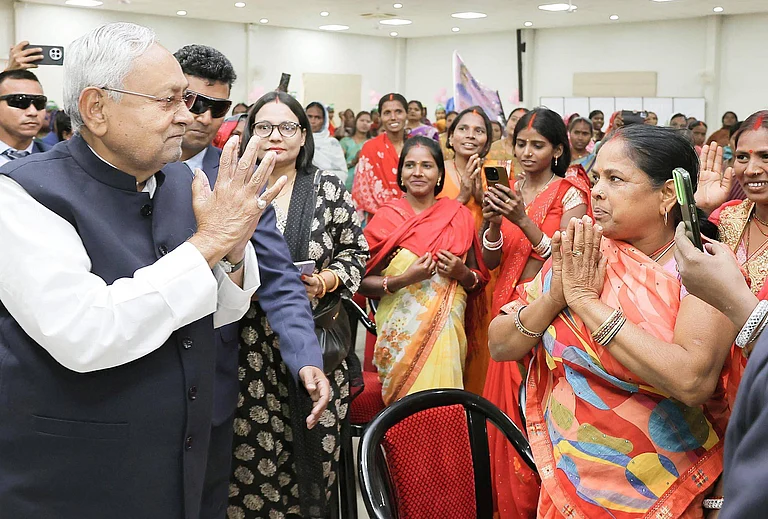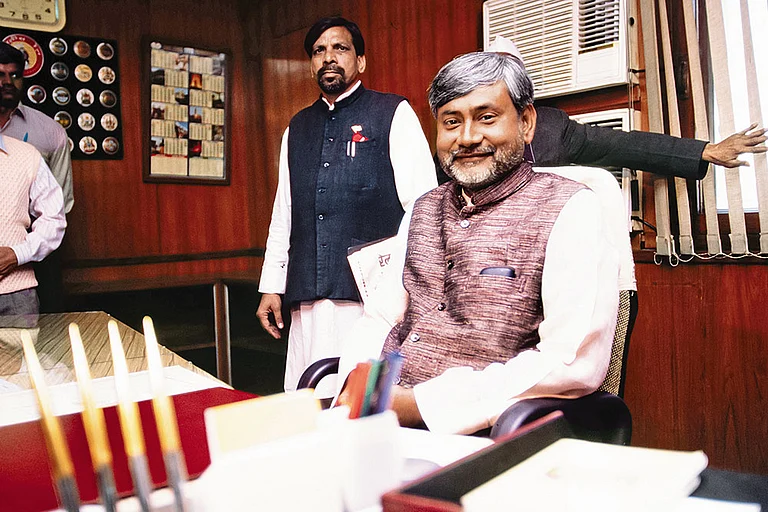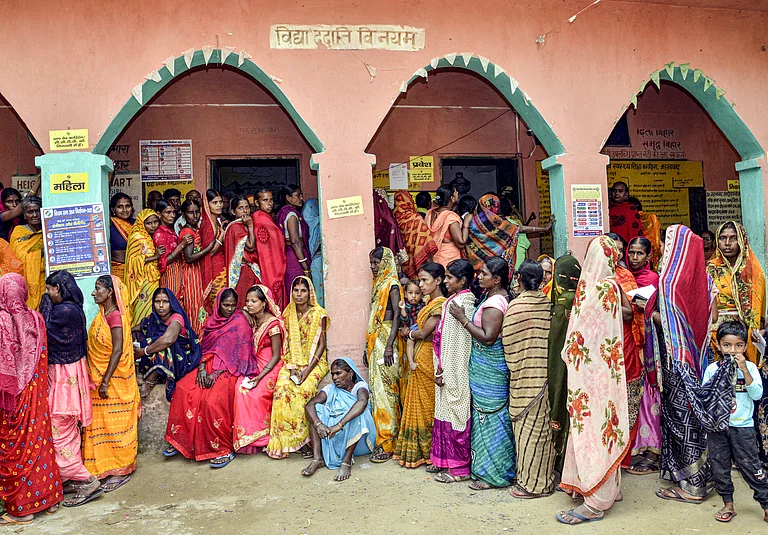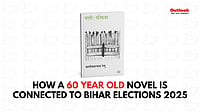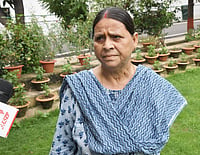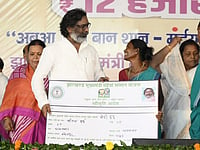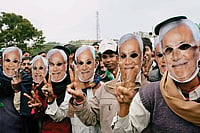
From bicycles and school uniforms to Panchayat reservations, Jeevika SHGs, prohibition, and 35 per cent job quota for women, Nitish Kumar steadily constructed a long-term ecosystem of female empowerment.
The recent Rs 10,000 transfer to 1.41 crore women—enabling micro-enterprises—became the most decisive factor in the election, mobilising low-income women beyond caste lines.
With historic turnout (71.8 per cent) surpassing men by 8.2 points, women emerged as Nitish’s strongest and most dependable constituency, transforming the political landscape and driving the NDA’s sweeping victory.
In Bihar, between Khagaria and Bhagalpur lies the Naugachia block. About five kilometres from its centre, on a roadside stretch, is located Mahadatpur village. Along a lane branching from this road stands the house of 27-year-old Khushbu Kumari. A month ago, when her bank account received Rs 10,000 under the Chief Minister’s Rozgar Yojana, Khushbu immediately used the money to set up a small tea-and-biscuit stall.
“This money has been a huge support,” she says. “My husband, Gaurav Kumar, rears cattle while I run this stall. We have two children who study in a good school. Nitish Kumar has changed the lives of women like us. Because of Alcohol prohibition, I can run this shop on the roadside, earlier, drunk men would create a ruckus. Crimes were common.”
Whether prohibition is truly successful on the ground in Bihar is a matter of debate. But for Khushbu, the self-reliance that came from the government’s 10,000 grant is directly linked to that very decision. It is true that alcohol is still sold and consumed covertly, but the open public nuisance such as street violence, verbal abuse, and domestic assaults, has reduced significantly.
Khushbu believed she had voted for the right Chief Minister, and her belief seems vindicated. What she did not expect, however, was the scale of the election result.
The Bihar Assembly verdict has been like an unanticipated storm, one that even a 21st-century meteorological department would have failed to predict. The NDA’s massive victory, its second such sweep after 2010, has widened the gulf between the ruling bloc and the opposition. Winning 202 of the state’s 243 seats, the NDA’s performance still leaves voters wondering how such a political tornado swept across Bihar without obvious signs on the ground.
Professor Rakesh Ranjan of Patna University’s Political Science Department says the 10,000 transfer was a decisive factor. It influenced women to the extent that many voted beyond caste considerations.
According to him, women in Bihar fall into three categories. The first is the higher-income group, which largely votes according to the preferences of their partner. The second is the middle-income group, which behaves similarly. The third group, however, the low-income bracket, is increasingly emerging as an independent voter. These women typically engage in small occupations such as running carts, selling goods, or self-employment. Many of their husbands migrate for work, leaving them to independently decide whom to vote for. This group, he says, was profoundly swayed by the Rs 10,000 announcement.
Just a month and a half before the elections, the Chief Minister Mahila Rozgar Yojana transferred Rs 10,000 directly into the accounts of nearly 1.41 crore women. This was projected as a major step toward women’s economic empowerment. The amount targeted members of SHGs or aspiring members, enabling them to start their preferred enterprises. After six months, women whose businesses grow may receive additional assistance of up to Rs 2 lakh.
Another example of how deeply this financial push shaped women's choices is Meena Devi, 40, from Saipnairi village in Gaya district. Just 48 hours before the first phase of polling, on 4 November, she bought a goat from the Khijarsarai market, something she had long wished to do. Smiling, she said, “We will vote only for Nitish Kumar’s party. No one else can influence us now. I had been struggling to buy a goat; the government money solved my problem.”
Meena belongs to the Musahar community. Her village is only two kilometres from Mahkar, the ancestral village of former Chief Minister and Union Minister Jitan Ram Manjhi. Yet her choice remains firm: Nitish Kumar. She admits she doesn’t vote in every election, but this time, she certainly has and only for Nitish.
Professor Rakesh Ranjan adds, “This election, women voted almost caste-neutral. In the 2020 post-poll survey by CSDS, 38 per cent of women voted for the Mahagathbandhan and 37 per cent for the NDA, just a one-per cent gap. But in the 2024 Lok Sabha election, women voted for the NDA in larger numbers. And the 14 November results show a far stronger tilt. Women cast four lakh more votes than men, and their turnout was historic.”
Bihar recorded 66.9 per cent turnout, the highest since 1951. Women voted at an unprecedented 71 per cent, outperforming men (62.8 per cent) by 8.2 percentage points.
Professor Ranjan argues that this overwhelming support for the NDA came from women, crediting Nitish Kumar for it.
The discussion now is that women have become Nitish’s most solid and dependable vote bank. Just as he carved the Extremely Backward Class (EBC) bloc out of the larger OBC grouping, he has now consolidated women as a distinct political constituency through sustained policy focus.
Out of Bihar’s 7.43 crore voters, 52.8 per cent were men and 47.1 per cent women.
Explaining how Nitish built this base, Professor Ranjan traces the strategy back to 2005, when law and order in Bihar was severely deteriorated. Poor law and order affects women the most. After coming to power in 2005, Nitish improved security conditions, significantly reducing violence against women. This laid the foundation for his women-centric governance model.
Since 2006, Nitish Kumar’s schemes for women have been consistent, strategic, and transformative. He launched Jeevika to organise rural women into SHGs; today over a million women are associated with it. In 2006, he introduced the landmark bicycle and uniform scheme for girls. This boosted female school attendance and was later extended to boys.
In the same period, Bihar became the first state to implement 50 per cent reservation for women in Panchayati Raj institutionsconsidered a historic boost to grassroots female leadership.
The prohibition in April 2016 was largely driven by women’s demands, who hoped it would reduce domestic violence and crime.
In 2018, came the Kanya Utthan Yojana, offering up to 50,000 for a girl child’s education from birth to graduation.
In January 2016, the government implemented 35 per cent horizontal reservation for women in all state government jobs, including police and administrative services.
Former AN Sinha Institute director, Dr D.M. Diwakar, considers Nitish Kumar highly sensitive and farsighted on women’s issues. Since the days he split from Lalu Prasad to form the Samata Party, Nitish knew that with his caste comprising under 3 per cent of the population, he had to build new political constituencies. He strategically mobilised Extremely Backward Classes (EBCs), subdivided Dalits into Mahadalits, and simultaneously cultivated women through targeted schemes. “Today, women are Nitish Kumar’s biggest vote bank,” Divakar says, “and that is no exaggeration.”
According to him, the seeds of this consolidation were sown through the Panchayat reservation and the cycle-uniform scheme. Millions of girls who once received bicycles are now adult women voters—educated, empowered, and politically aware.
Khushbu Kumari is one of them. Now 21, she has voted thrice, first in the Panchayat elections, then in last year’s Lok Sabha polls, and finally in the 11 November Assembly election. A voter at Booth No. 361 in Imamganj constituency, she voted for the NDA-aligned HAM party candidate. When asked if she would still vote for the candidate had Nitish not been in alliance with HAM, her reply was firm, “If not Nitish Kumar, then whom? He gave us cycle, uniforms, scholarships, Rs 6,000, and Rs 10,000 after passing intermediate.”
Coming from the Mahadalit community, Khushbu is the first graduate in her family. She recalls that when she received her bicycle in Class 9, her three-kilometre ride to school became so easy that she never missed classes again.
Women’s turnout in Bihar surged notably after 2005 when Panchayat elections granted them 50 per cent reservation. Before that, men consistently out-voted women in every election since independence. After 2005, women have consistently led.
2010: Women 54.44 per cent | Men 51.11 per cent
2015: Women 60.48 per cent | Men 53.32 per cent
2020: Women 59.69 per cent | Men 54.45 per cent
2025: Women 71.78 per cent | Men 62.98 per cent (record-breaking)
Dr Divakar notes that earlier, women’s “focus votes” were largely managed by polling agents. But after Nitish’s reforms, especially Panchayat reservations, women became assertive political actors. Many became mukhias, Zila Parishad members, and ward leaders. Subsequent schemes continued to reinforce their political agency.
Months before the latest Assembly election, the government announced a cascade of women-centric measures such as reduced interest rates and doubled honorarium for Jeevika didis, domicile-based eligibility for women’s 35 per cent job reservation, increased honorarium for ASHA and Mamta workers, higher social security pensions (from 400 to 1,100), and interest-free loans under the Lakhpati Didi initiative. Finally, the 10,000 transfer before elections transformed the political atmosphere entirely.
In the end, the Bihar election results underline a quiet but decisive political transformation driven by women. Over two decades of consistent policies, from law-and-order reforms and Panchayat reservations to bicycles, scholarships, Jeevika networks, prohibition, and finally the 10,000 Rozgar Yojana transfer, have turned women into Nitish Kumar’s most loyal and influential vote bank. Their record turnout and caste-neutral voting not only reshaped the 2025 verdict but also signalled that in Bihar’s evolving politics, the empowered female voter is now the most formidable force.








